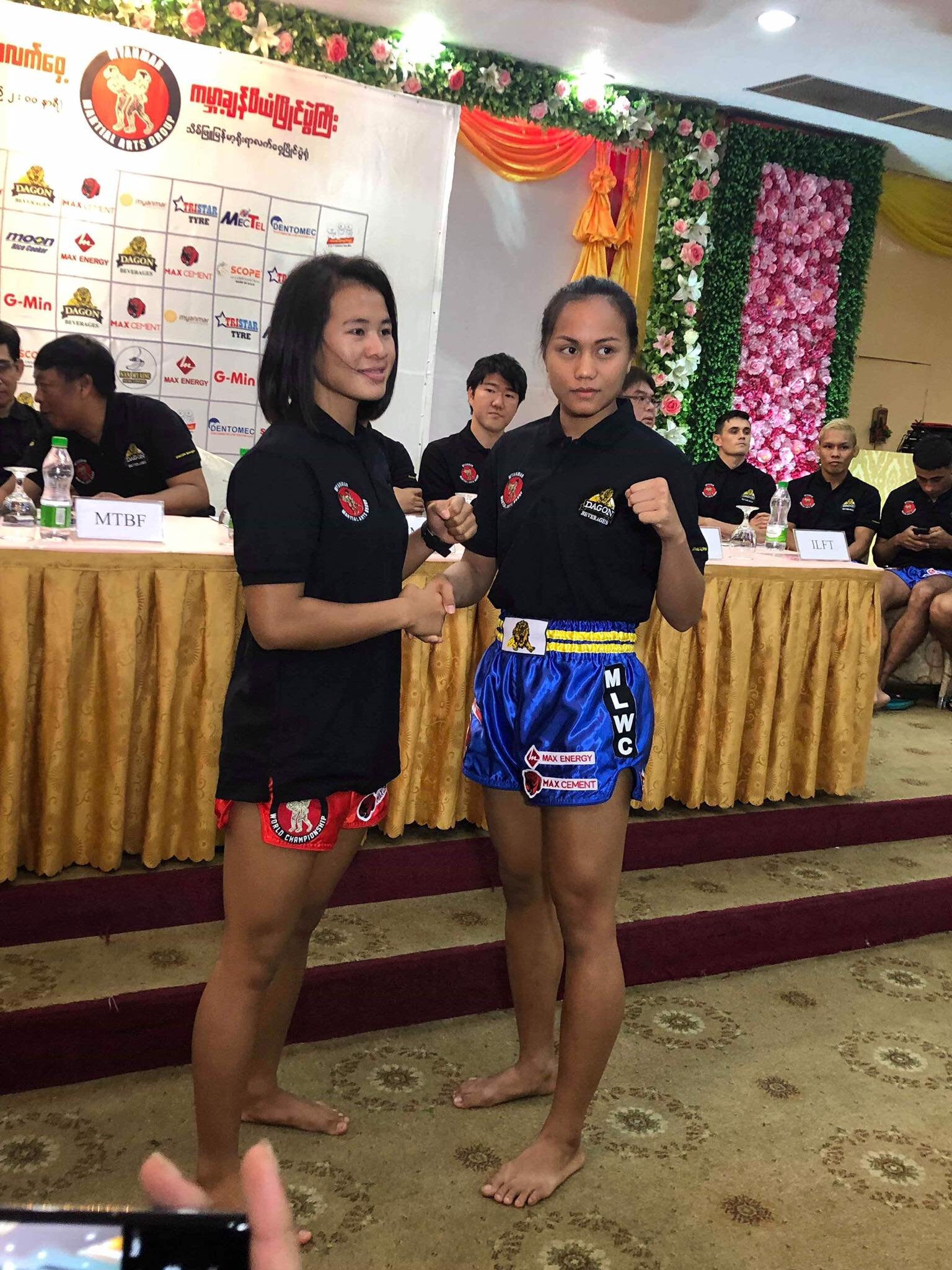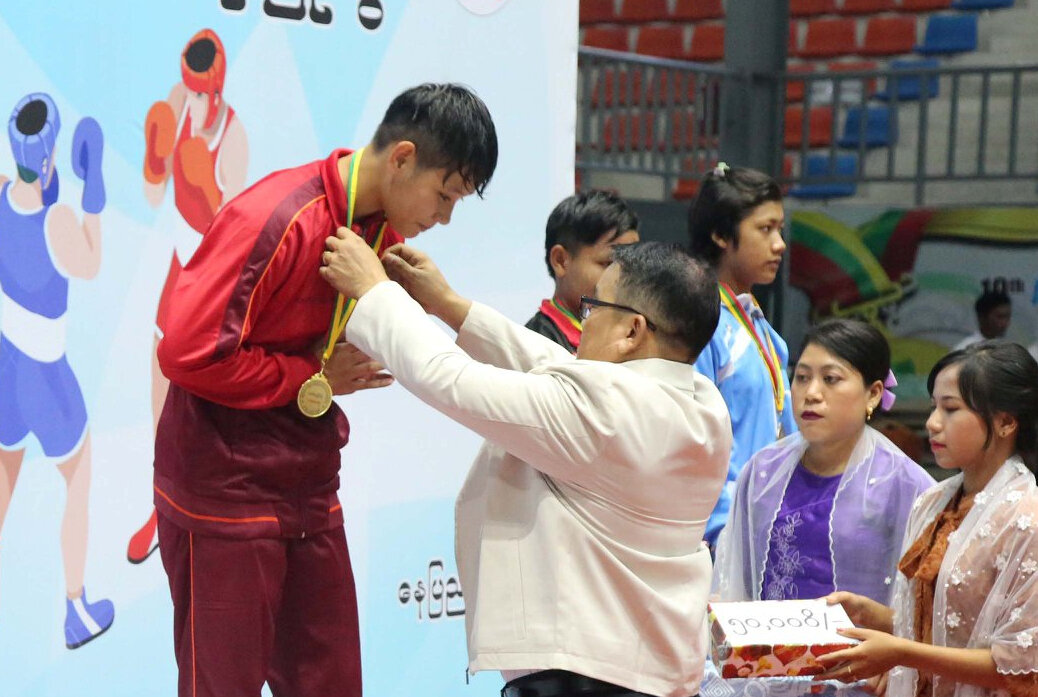State of Women's Lethwei
There are very few females competing in lethwei, the amount of foreigners far outnumber the native participants.
Veronika and Sawsing Sor.Sopit at a press conference prior to the 4th Myanmar Lethwei World Championship on August 18th. Photo courtesy of Myanmar Lethwei Collection.
You would think that in an organisation like WLC, for example, they would show off their national talent at every opportunity, but so far we've only seen Shwe Sin Min, Shwe Nadi and Eh Eh. However it's not the company that is at fault. The field is incredibly thin outside the confines of WLC. In traditional lethwei there are only a handful of girls available, willing, and able to compete regularly.
Whether you look at 1999, 2009 or 2019, the roster has never really grown. After polling, I learned that in decades past there were actually more active women in lethwei than there are now. In every decade there are only a handful of standouts able to compete against formidable opponents in- and outside of the country's borders.
Historically Myanmar is a very conservative thinking country in that regard and perhaps young women entering a lethwei ring in order to make a statement may still be seen as social engineering. In the old days women didn't particularly favor the brutality and did not engage in fights. There has always been a strict gender role enforcement ingrained in a male dominated society and that's not easily changed. Over time there have been gradual changes in both the sport and the public’s attitude towards women choosing a career in boxing or lethwei, but it has not yet shown significant improvement in relation to activity in the ring.
There have been vows over the past few years to increase interest in the women’s divisions, so far without any tangible results. The yearly Regions & States (also known as States & Divisions) tournament attracts an incredible amount of female competitors from all over the country, most of whom have never set foot in a lethwei ring and strangers to many eyes. It's no surprise that most of them are eliminated early and see their hopes of attaining a medal shattered swiftly.
Roughly 80% of those who enter these tournaments will not return to the arena to consider a career in lethwei. Those who do win gold were already recognized as the top of their class and the only thing their participation helped achieve was clearing out the newcomers stepping up to fill a void and crushing their dream, if they had one to begin with.
May Thazin Htoo faces Shwe Ko Lay in the finals of the Golden Belt Championship on July 13, 2019. Photo courtesy of Myanmar Lethwei Collection.
Last year was a historic moment for women however when they were allowed to participate at the Golden Belt Championship for the first time since its inception in 1996. Two weight-classes were offered initially, 49½-53 and 60kg, but due to the lack of sign-ups for the 60kg division it was not included. Only four girls ended up fighting in the championship.
You'll often hear boxers say that their family or at least a family member was opposed to them fighting. This is true even more so for the women, especially after any degree of success or achievement. Why would you risk getting beaten up after you have already received a medal or a flag? Why would you even consider trying again after you have failed to do so. Another factor is the act of marriage which ties in to the traditional belief that women should take care of the household. A lot of girls in the past have stopped returning to the ring after getting married. Ultimately it is their own choice, but since numbers are dwindling, family involvement still seems to play a role.
Kay Thwe Nyein receives her boxing gold medal.
Many girls cross over from gloved boxing. At least half of the women recently active have previous or ongoing careers in boxing, which only adds to the lack of participation in lethwei if they switch back to boxing for an unknown period of time. For every lethwei fight they can have so many more boxing fights, simply because it's safer with 12 ounce gloves and headgear. Purely by happenstance I can give you the example of Kay Thwe Nyein who last fought against Shwe Ko Lay in January and has just won a gold medal in the 47th State and Division Boxing competition this October (pictured). Even though she remains undefeated in lethwei with 7 fights, she currently has no confirmed bouts and will have been absent for a year, come 2020.
In 2018 I have kept track of all the online advertised lethwei events. This includes all announced fights, even though some might have been cancelled as results are not always easy to come by. It’s the act of making the fight initially that counts here, even if it ended up being scrapped. Gathering the statistics from events involving women, both domestic and foreign, I came up with the number 42. Forty-two fights in one year, that's just short of one fight a week. That's not much considering I tracked roughly 2000 fights involving men.
Top performers in the last two years.
If I add up all the known fights for 2019 so far, I get to 35. The reason there are less women with more than one fight in 2018 is because of the Regions and States tournament in June. As you can see Linn Yon May has vanished as she got married earlier this year and has not been on the radar since.
“In the southern town of Myeik, three teenage fighters are beating traditional views of women by punching their way into the male-dominated world of Lethwei kick-boxing.”
The above report portrays Phyu Phyu Khaing, Kay Thwe Nyein and Shwe Sin Min (Thae Pwint Phyu) as boxers helping to bring down stereotypes in Burmese society. The irony is that Phyu Phyu Khaing only fought twice in last years Regions & States since the video was published in 2016 and has not returned since. Shwe Sin Min has not had a fight since February of last year and has also vanished. As mentioned above, Kay Thwe Nyein has been absent for a year and her return to lethwei will always remain a guess.
Although the roster might not have grown, over the past 10 years women’s lethwei has gotten a slightly better reputation. But how does this so called ‘breaking of barriers in gender inequality’ translate to active competition in the ring? Has it really changed for the better, so that people can be hopeful of a future with at least one women’s bout on every card? Most of the people I have asked don’t think there will be any drastic changes anytime soon. A prospect recently discovered might vanish the next day, so reluctance in investment remains.
Kyu Kyu Thin, a successful boxer active 25 years ago. Seen here with coach Patma Sein.
In short, it looks like popularity and acceptance (or tolerance if you will) of women in lethwei is slightly on the rise, while the actual number of women competing seems to stagnate if not diminish. It is a huge contrast with the neighboring sport of Muay Thai.
Lethwei is a male dominated sport, with a largely older audience, where high intensity action is expected and demanded. Perhaps to some, women do not fit that picture and their fights do not elicit the same satisfaction. Hopefully it’s just a stage in evolution and the actual numbers of consistently active athletes will increase over time.
There are murmurs among fans that the sport might gradually change to a point where only the modified rules are used (no time out and inclusion of judges). Whether these visionary changes would increase women’s participation in lethwei is anyone’s guess at this point.
Header: Naw Ohn Mar Soe after her first round victory over Htet Htet Kyaw on September 12th this year.





